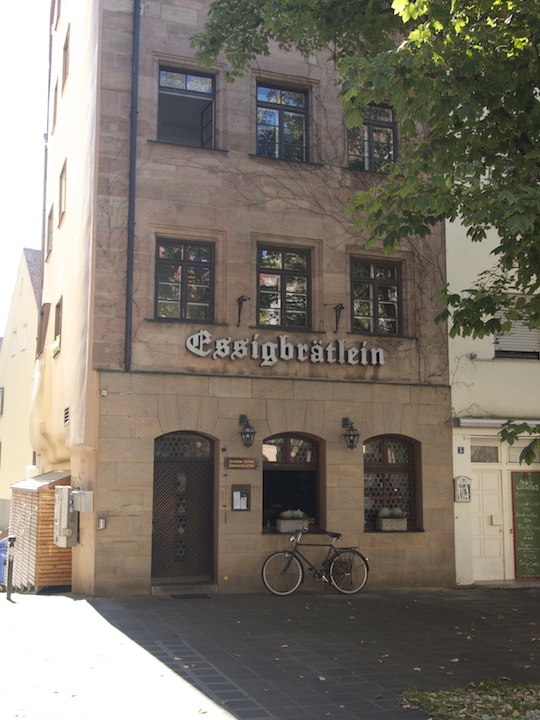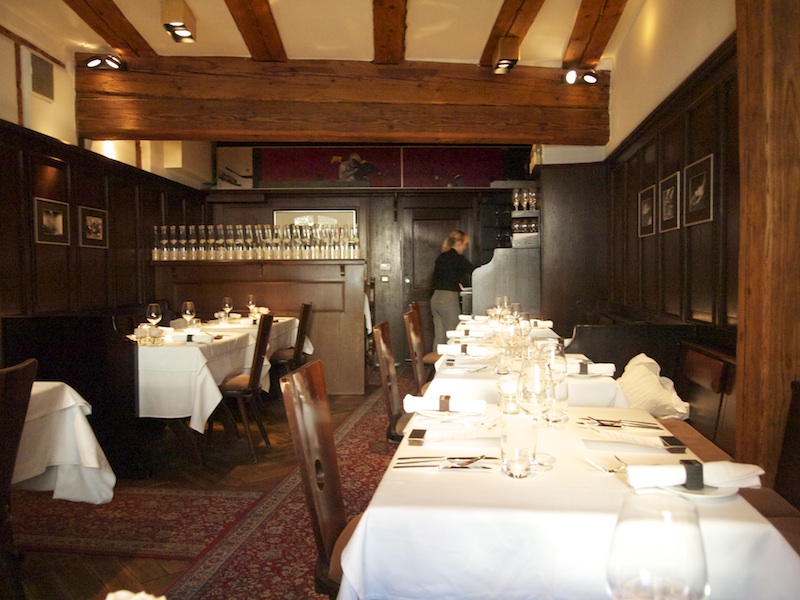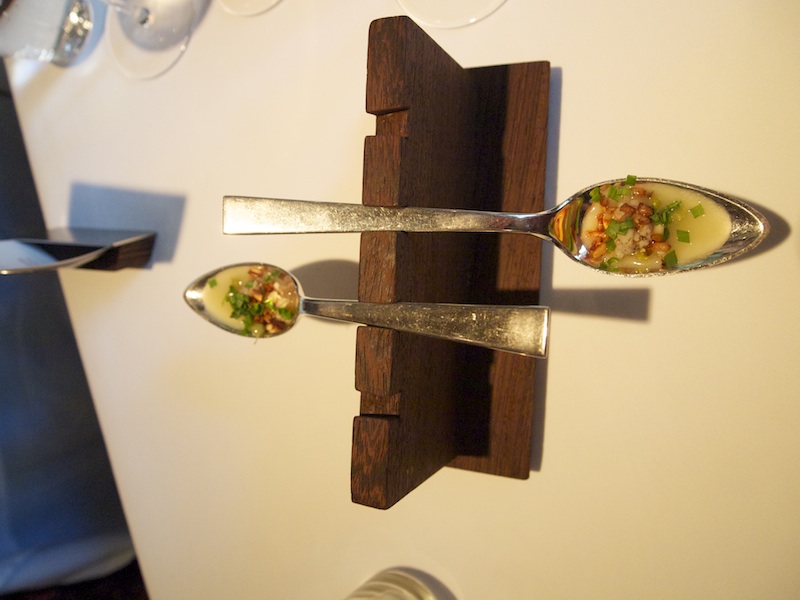Rating index:
Extraordinary (96-100)
Outstanding (93-95)
Very good to Excellent (89-92)
Above average to Good (86-88)
Below Average to Average (80-85)
Avoid (below 80)
More info >
Extraordinary (96-100)
Outstanding (93-95)
Very good to Excellent (89-92)
Above average to Good (86-88)
Below Average to Average (80-85)
Avoid (below 80)
More info >
Restaurant Essigbrätlein in Nuremberg in Bavaria is housed in a building (Weinmarkt 3) that represents almost 500 years of gastronomic history. In 1550 the establishment was already referred to as "des Senzenwirts am Weinmarkt Eckbehausung" and as "Fässla" in 1596 in the city's annals. The designation "Essigbrätlein" is first mentioned in 1648 - a reference to the "Sauerbraten" served there. The building has survived more or less intact to this day: in the January 1945 bombing raid on the city the roof and third floor of the building were destroyed but not the ground floor where the 20-cover restaurant, opened in 1989 by Andree Köthe, is located.
Köthe, a self-taught chef, was joined in 1997 by chef de cuisine Yves Ollech. In 1999 the restaurant was awarded a Michelin star and the second followed in 2007 (2008 guide). In 2012, Andree Köthe was named chef of the year in the Gault Millau Germany guide. The restaurant is well-known for its creative and innovative use of herbs and spices - they refer to it as "Gewürzküche".


Essigbrätlein is open for lunch and dinner Tuesday till Saturday. For lunch there's a 5-course set menu for €92.50 on offer (4 courses if you arrive after 12.30!) and for dinner there's a 7-course set menu for €125 (price as per the Michelin guide; the restaurant does not have a website). I had lunch at Essigbrätlein with my husband on Thursday 5 September 2013 and since we there around noon, we had the pleasure of sampling 5 courses.
Lunch started with three amuse bouches. First some roasted oats, cooked oats and appel-oat juice with unripe red currants, served on a spoon. This was followed by a yellow cherry tomato topped with evening primrose and crunchy amaranth. Two nicely presented amuse bouches but the flavours were distinctly cold. The final amuse bouche was fresh corn with chopped mushrooms in a light creamy sauce, topped with corn silk. The textures were pleasant and there was a nice salty finish.
Lunch started with three amuse bouches. First some roasted oats, cooked oats and appel-oat juice with unripe red currants, served on a spoon. This was followed by a yellow cherry tomato topped with evening primrose and crunchy amaranth. Two nicely presented amuse bouches but the flavours were distinctly cold. The final amuse bouche was fresh corn with chopped mushrooms in a light creamy sauce, topped with corn silk. The textures were pleasant and there was a nice salty finish.



Next to arrive was the bread. Carrot-celery bread served with green bean butter. The bread had a rather dense texture and I didn't like the butter.
First course of the lunch menu was broccoli stem, crunchy broccoli leaves, broccoli juices, unripe red currants, edible geranium and some peanut sauce. The broccoli stem came in two ways: finely chopped pickled stem and two large, disturbingly undercooked (no, this was not 'al dente'), pieces of stem that should have not been on the plate. The peanut sauce added some much needed warmth to this otherwise very 'green' dish with lots of nondescript broccoli flavours. Peanut sauce combined with (raw) vegetables can be a great combination (e.g. in the Indonesian dish gado gado), but in this case it didn't work.

Marinated trout with confit lemon, pickled beetroot, crispy trout skin and an elderberry and whey sauce were served next. Well-marinated firm trout and the elderberry and whey sauce delivered a nice light creaminess. A decent dish, but the trout flavours got lost when combined with the bitter-sweet lemon and pickled beetroot.

An onslaught of green and raw flavours followed. Peas, broad beans, runner beans, pickled cucumber, marinated grapes, strips of apple, local leaves (?), purslane and dill flowers, served with a pistachio sauce and pickling juices. A dreadful dish that was crying out for some warmth. You can only put so many raw flavours/ingredients on a plate.

Thank heavens there was some meat next. Nice, juicy lamb served with flavoursome grilled (white) leek, finely shredded raw (green) leek and a quite sharp yoghurt cream. Nice warmth from the caramelisation on the grilled leek. Unfortunately the shredded leek gave the dish an unpleasant raw and sharp finish.

By this time I was thinking, hoping, praying that dessert would be alright. What can go wrong with a dessert ? Guess again. Poached apricots topped with puffed rice and lime blossom, served with a milky ice cream made from milk in which apricot kernels had been cooked. The apricots were rather nice on their own, but in the dish all I could taste were the lime blossoms. Worst of all was the wall paper paste that turned out to be rice pudding masquerading as glue.

To say that I left Essigbrätlein in a state of confusion and with mixed emotions after my worst meal in recent years, would be a serious understatement and a misrepresentation of my feelings at the time. In fact I was baffled and deeply unhappy. Baffled that a restaurant that has two Michelin stars, gets 18/20 points in Gault Millau Germany and 4/5 "F" in the Feinschmecker guide would turn out food that is actively unpleasant. Baffled that I was asking myself the question what would more disturbing: to find that no-one had bothered to taste this food before it was served, or to find that someone had (which I fear was the case). Deeply unhappy that I had had to work my way through a disgraceful parade of unbalanced dishes that all lacked warmth and deliciousness and left me dissatisfied in more than one way. The first thing I did when we arrived at our hotel in Frankfurt later that afternoon, was to order a Currywurst (no really, I did).
If I don't get this cuisine, feel free to call me stupid, but I have visited more than 40 two-star restaurants in Europe in the last 18 months (of which 12 in Germany - and 6 out of Germany's 10 three-star restaurants too, for that matter) and never have I encountered anything remotely like this. This is culinary extremism of the worst kind. To put it more mildly: like molecular gastronomy this is a type of cuisine that can be great in the hands of a culinary genius but turns into "the emperor's new clothes" in the hands of others. For a moment I thought I was on Candid Camera. I have no idea what this chef is trying to achieve, but the result does not qualify as good gastronomy. Hence my appeal and challenge: "Mr. Michelin, tear down these stars."













